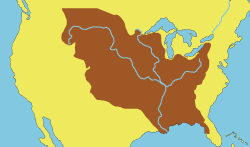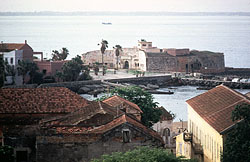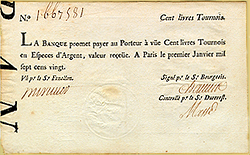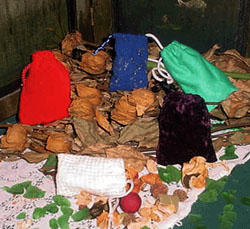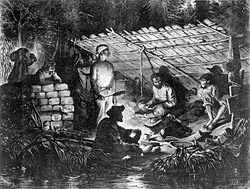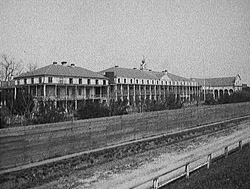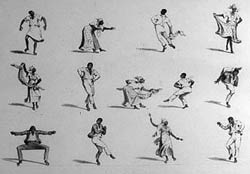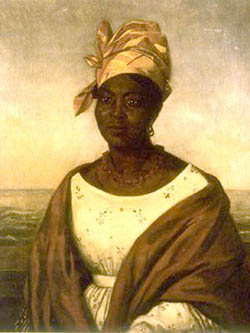Africans in French America
French America, or New France, was a frontier and a borderland. It consisted of the St. Lawrence Valley (Canada), Acadia (Nova Scotia), the Great Lakes, the Illinois County, and the Lower Mississippi Valley. The Louisiana territory itself was greater than 2 million square km or 800,000 square miles. In terms of the modern day United States, New France consisted largely of Louisiana on both sides of the Mississippi, Arkansas, Missouri, Iowa, Minnesota west of the Mississippi, North and South Dakota, Nebraska, Oklahoma, most of Kansas, and portions of Montana, Wyoming, Colorado east of the Rocky Mountains, and Mississippi. Colonial Louisiana was under the administration of two different European powers, France (1699–1763) and Spain (1763–1800), before being sold to the United States in 1803 by Napoleon.
This section of Module I focuses on the Louisiana territory as it relates to the modern United States. Specifically of interest is the founding and settling of Louisiana and the role of people of African descent in this process. In order to better understand the historical importance of this piece of African American history and heritage, a few topics will be explored including: the arrival of people of African descent; distinctions made between Africans; medical cures; subsistence; the impact of law on daily lives; religion; the building of the colony; and cultural resistance.
Louisiane or Louisland
The Spanish explored the territory of Louisiana as early as 1519 during De Pineda’s expedition confirming the discovery of the Mississippi and from 1539–1542 during De Soto’s overland expedition (Louisiana State Museum 2004). Louisiana would not again be of interest to European powers until the late 1600s when King Louis XIV encouraged further exploration of the Mississippi River. By 1682, Rene-Robert Cavelier, Sieur de La Salle claimed the Mississippi River and all of the land surrounding it naming the territory Louisiane or Louis land.
In 1699 the first permanent settlement was established by the French at what is now present day Biloxi located along the Gulf Coast of the Mississippi River. The first census at Biloxi counted five officers (two of which were Canadian), five petty officers, four sailors, nineteen Canadians, thirteen pirates from the Caribbean, ten laborers, six cabin boys, and twenty soldiers (Hall 1992:3). From its inception, Louisiana was a slow growing colony due to the lack of financial support it received from the French government and the lack of laborers to build the colony (Ingersoll 1991:174). As a result, many colonists were forcefully persuaded to journey to Louisiana.
In order to populate the area, the French resorted to importing prisoners, beggars and vagabonds; poor people convicted of minor crimes. According to Gwendolyn Midlo Hall, “[T]he French colonization of Louisiana became to a great extent a penal colonization” (Hall 1992:5). French prisoners were sentenced to work in Louisiana for three years. Many French citizens involved in what was termed “antisocial” behaviors were simply deported to the colony. After mounting complaints from colonial residents and a number of French deaths in the voyage to Louisiana, the deportation of French citizens was abolished.
To aid in expanding the colony in terms of people and profits, the John Law Company (later called the Company of the Indies) was granted the administration of Louisiana in 1707. The Law Company was given a monopoly on Louisiana trade for 25 years, Canadian beaver trade in perpetuity, ownership of land and mines, the right to build fortifications and the right to nominate company directors and colonial officers. According to Alice Dunbar-Nelson, the company had a stipulation in the charter to bring over 6,000 whites and 3,000 “Negroes” to be sold for half cash and the balance of one year’s credit to people who had lived in the colony of Mississippi for at least two years (Dunbar-Nelson 1916:363). During the first year in which the Law Company was given the administration of the colony, 1,000 slaves were transported from Africa.
As the colony grew and shifted boundaries as a result of the possession of more land and increased population, the number of people of African descent grew. The 1726 census counted “3784 people: 2,240 whites (including 245 indentured servants and 332 soldiers), 1,385 black slaves, and 159 Indian slaves” (Hanger 2004a: 2). The French faced opposition to the peopling and building of Louisiana during the 1729 Natchez Indian revolt in which 1 in 10 of the colonists were killed.
Prisoners, American Indians, and voluntary settlers did not constitute enough manpower for the French colonists to sustain this strategic outpost of the French Empire. Slaves of African descent were desired as unpaid labor due to the fact that Indian enslavement did not meet the labor demands of colonists. African slaves were also needed as “bondspersons” to “exploit colonial resources to their fullest potential” (Hanger 2004a: 7). The Louisiana censuses show that each year the number of slaves of African descent increased and that by the 1740’s the colony’s African population was mainly creole or born in the Americas. A resurgence in African arrivals would not take place on as large a scale again until the 1780’s. Under Spanish rule, during these years, the slave population grew by 250% and the number of free persons of African descent increased sixteen fold.
Louisiana and the African Arrivals
Between 1719 and 1731, two-thirds of the African slaves bought to French Louisiana came from the Senegambia—a region between the Senegal and Gambia Rivers. The peoples who lived in that region and were later transported to be enslaved in Louisiana had an intricate knowledge of rice and corn cultivation as well as cotton, tobacco and indigo. Many people from the Senegambia shared common cultural knowledge as a result of living amongst each other for centuries and most had converted to Islam, with the exception of the Bambara.
The Louisiana census of 1708 did not count any Africans amongst the settlers, however, by 1712 there were ten inhabitants of African descent. The remaining slaves to come to Louisiana would arrive directly from Africa and were bought to the region during the 1720’s and the 1780’s. Between 1719 and 1723 some 2,083 slaves were imported into the struggling French colony (Gehman: 1994:9). Scholars of the slave trade have found that the trade in slaves is well documented by the French not only in France, but also in Africa and on board the slave ships themselves.
In the literature of the day, enslaved Africans were identified according to the geographic location of their origins. Travel accounts throughout the region given by George W. Cable and M. Le Page du Pratz, among others, identified Africans as Senegalese, Mandingo, Foulah, Sosos, Negroes, Popoes, Cotocolies, Fidas, Socoes, Agwas, Mines, Nagoes, Fonds, Ibos, Angoloas, and Congoes. That these distinctions were noted attest to the fact that ethnic distinctions were being made between Africans and were well documented.
Upon arrival to Louisiana in 1719, many Africans encountered indigenous peoples as fellow slaves. They eventually formed alliances and occasionally escaped together toward the promise of freedom. The French, seeing the potential for alliances between groups, would offer rewards in the form of goods to Native Americans for the return of runaway slaves. During the administration of Gov. Bienville, the Code Noir or Black Code was enacted in 1724 to further limit the influence of Africans in the colony and to prevent desertion.
The Code Noir accomplished a number of things. Its sixty articles ensured that the movement of people of African descent was severely restricted, the status of those with darker skin was always lower than people of lighter complexions, contact between “racial” groups was intentionally thwarted, and that instruction in the Roman Catholic faith was given to all subjects. There were also articles within the Code Noir which were meant to ensure the safety of slaves as profitable merchandise. In accordance with Articles 22–25, masters were to provide food, flour, cassava, fish, fabric, and other provisions to ensure that their slaves were properly cared for and could, therefore, work productively. The Code Noir also allowed slaves to report masters to the authorities if they were not given these provisions. However, although these Articles were a part of the Code Noir, they were not always followed nor enforced and many slaves resorted to running away.
Colonists in the Louisiana territory could not afford runaways literally. Many of the earlier colonists could barely afford to pay for Africans who arrived at various entry points. For those who could not afford to pay for slaves in hard money, the Company of the Indies accepted paper money. If the colonists failed to pay off their debts, the slaves were returned to the Company or paid for in-kind, that is in non-cash contribution paid for in services or goods (Hall 1992:63). Times were so difficult for these early settlers that many sold their slaves to the Spanish and others in return for transportation out of the colony, even though if caught they would be subject to a penalty of a thousand livres and confiscation of their slaves (Dunbar-Nelson 1916:363).
M. Le Page du Pratz
Due in part to the “expense” of enslaved Africans and their descendants, the health and “management” of slaves was, in theory, paramount. In order to maintain the health of Africans and African-Americans, various medical remedies were used. Knowledge of homeland cures, herbs, and foods from the African continent were vital in sustaining the health of not only African arrivals, but their contemporaries as well. As Kimberly Hanger points out “[C]olonial Louisiana healers employed contemporary European treatments and borrowed cures from Louisiana Indians and Africans in their constant battle against disease” (2004b: 8–9). Because of limited medical supplies and the ineffectiveness of European remedies on some “New World” diseases, settlers acquired knowledge of herbs and roots from Indians, Africans and African-Americans.
M. Le Page du Pratz, pharmacist, administrator and resident of colonial Louisiana, offers an example of one man's view on how medical practices were adapted and borrowed, between not only French and African cultures, but Indian cultures as well (Hanger 2004b). His 1774 account entitled The History of Louisiana or the Western Parts of Virginia and Carolina: Containing a Description of the Countries that Lie on Both Sides of the River Mississippi offers insight and advice on all matters concerning Louisiana. His insight regarding the “superstition” and management of slaves is helpful when trying to understand the assumptions made about African arrivals, their “superstitions,” cosmology, and healing practices.
To begin, it should be noted that du Pratz is not the definitive voice on assumptions made about African arrivals in Louisiana. However, his observations as a part of the Company of the Indies suggest that he acknowledged the “intelligence and rationality” of Africans (Galloway 2003:5), concepts that his contemporaries may not have been able to imagine in regards to African control of individual and collective futures. Du Pratz gives readers some insight into his observations held during this time when he states, “[T]he negroes must be governed differently from the Europeans; not because they are black, nor because they are slaves; but because they think differently from the white men.” (Du Pratz 1774 [Tregle 2004]). In order to illustrate these differences, he introduces his readers to the “superstition” of slaves arriving to the region. According to his accounts, slaves are
…very superstitious, and are much attached to their prejudices, and little toys which they call gris, gris. It would be improper therefore to take them from them, or even speak of them to them; for they would believe themselves undone, if they were stripped of those trinkets. The old negroes soon make them lose conceit of them. (Du Pratz 1774 [Tregle 2004])
From this passage, one can see that Africans arrived in possession of gris-gris (a charm used to harm others and to ward off evil). In Africa, gris-gris or charms of various sorts were “…regarded as having a spirit of its own and having taboos which its users had to observe if it were to work” (Raboteau 1978:82). Gris-gris and other amulets would later play a significant role in African traditions in the Americas. It has also been suggested that Du Pratz recognized that Africans had different “learned systems of thought” and if given the opportunity were able to “learn new things from experience and the advice of others” (Galloway 2003:5).
Du Pratz addresses another superstition involving blood and wine which lead the French to speculation about why some Africans may have run away. He states that many Africans, upon seeing Europeans drinking dark red claret, believed that Europeans drank the blood of slaves. Due to this “superstition,” so Du Pratz believed, many slaves tried to kill themselves, (and some succeeded), in drowning themselves or deserting. Here he suggests that people of African descent that have been acculturated should be used to explain the French practice in order to decrease the potential for escape. Those who successfully deserted were called Marons (Maroons). Maron is French for African slave or descendant, and a derivative of the Spanish word cimarrones meaning wild ones- a term used to refer to fugitive slaves. These observations suggest that new African arrivals, whether as a result of superstition or other impulses, immediately resisted capture. Attempts at desertion and escape were frequently recorded in colonial documents and newspaper advertisements for runaways.
Social Stratification and African Difference
Not only does du Pratz give us information on superstitions; he also addresses the type of work done by many of the people of African descent in the region and the proper means by which to house them. According to his observations, in the lower part of the region especially, people of African descent do agricultural work. With regards as to housing slaves, he believed that “[P]rudence requires that your negroes be lodged at a proper distance, to prevent them from being troublesome or offensive; but at the same time near enough for your conveniently observing what passes among them” (Du Pratz 1774 [Tregle 2004]). Du Pratz is very specific in his accounts, even when referring to “negro camp[s]” and bathing quarters, which are to be buried a foot to a foot and a half in the ground and locked so as prevent children from drowning.
Du Pratz was also careful to distinguish between new African arrivals. He makes a distinction between the Senegalese and other Africans including those he called Congos, Angolas, and Aradas. According to du Pratz, “Senegals,” or Diolaufs as du Pratz says they called themselves, were of the purest blood (Du Pratz 1774 [Tregle 2004]), did not smell, were most loyal of all slaves, had a better understanding of their surroundings, were able to learn a trade, and were very grateful. Senegalese were also said to be good commanders over other slaves due to their fidelity and gratitude, "high-minded", and more intelligence than other African arrivals.
African Health and the “Negro Physician”
The health of enslaved peoples was essential to profitable work results regardless of their ethnic distinctions. When giving advice to those who purchased slaves, du Pratz cautions against buying slaves with yaws or scurvy. He stressed that when purchasing newly arrived Africans, one should be able to identify yaws or the virus of Guinea, a condition that left the skin “as smooth as a looking-glass” and was not easily detectable by European doctors. He also gave instructions on how to identify scurvy, a condition that results from a lack of vitamin C and can lead to bodily weakness, spongy and inflames gums, and anemia. Du Pratz acknowledges that he gained knowledge of how to cure patients from a “negro physician.”
Here the importance of knowledge gained from the “negro physician” cannot be overlooked for it is he, and not his European counterparts, who is able to diagnose and cure yaws or the “virus of Guinea.” According to du Pratz, this physician, like many of his contemporaries, had extensive knowledge of herbal remedies and cures. Through the process of acculturation, medical knowledge was passed on and recorded in history. Because of this physician of African descent and the knowledge he acquired and passed on, there were “cures” for yaws and scurvy that would benefit all in the colony. After the patient was treated, they were to be feed well and made to sweat. Du Pratz was also taught by this physician how to “cure all the distempers to which the women are subject; for the negro women are as liable to diseases as the white women” (Du Pratz 1774 [Tregle 2004]).
As can be seen by the perceived collaboration between these two men, knowledge of African ways was essential to the health of not only people of African descent, but Europeans and Indians as well. This acculturation process by means of apprenticeship would pave the way for many doctors including Santiago Derom, the first African-American physician in the United States.
New African arrivals faced a new and unusual world when they arrived in the territory of Louisiana. They brought with them knowledge of their homelands in the form of labor, food and medicine. They also brought with them their religious beliefs that would continue for generations to come.
African Religions: Old Wine in New Bottles
Just as Africans were imported into the French province of Louisiana, so too were their religion and religious beliefs. As Midlo-Hall states, “African religious beliefs, including knowledge of herbs, poisons, and the creation of charms and amulets of support and power, came to Louisiana with the earliest contingent of slaves” (Hall 1992:162). Court documents attest to the prevalence of charms, amulets and poison. Many of the charms used by enslaved people kept their African names through the journey across the Atlantic and through successive generations. The use of gris-gris and zinzin, an amulet of supportive power, illustrate this point. According to Midlo-Hall, these are original Mande terms. The Du Pratz account verifies the continual use of these names.
Article II of the Code Noir, however, specifically addressed religion in the colonies by stating “[A]ll slaves that shall be in our islands shall be baptized and instructed in the Roman, Catholic, and Apostolic Faith.” The influence of the Roman Catholic tradition was felt especially among women and female children with the help of the Ursuline nuns. Converted people of African descent also played a role in the spread of Catholicism.
Emily Clark and Virginia Meacham Gould address Afro-Catholicism, specifically with regards to women of African descent. According to the doctrine of the Ursuline nuns, female education was extended to all women, regardless of social standing. The influence of Catholicism upon women of African descent was central because it was the women, according to African traditions and customs, who were responsible for the instruction of their female children in terms of traditional religious observances. Men, in turn, were responsible for the instruction of male children.
Many women were affected by the Catholic religion because of the female missionary program available to them that was not available to men, of any race. The Senegambian and Catholic religious traditions were more easily intertwined because both practiced “…gendered division of piety and religious induction that cut both ways for the Catholic campaign for conversion among the enslaved of New Orleans” (Clark and Gould 2002) So effective was this instruction among women of African descent that they were instrumental in the baptism of enslaved men.
Women were not only influential in the baptism of people of African descent, they were also instrumental in establishing the practice of godparenting. It has been reported that in 1733, 2% of people of African descent were godparents. In 1750 that figure rose to 21%; by 1765 it was 68% and by 1775 it escalated to 89% (Clark and Gould 2002). For women and men of African descent, “[G]odparenting was the most formal way people of African descent laid claim to the resources and spaces of one of the city’s chief institutions and made it their own…Godparenting was an effective form of fictive kinship that helped recreate community and familial bonds, knit together the fractured polity of the enslaved, and advance both individual and group interest” (Clark and Gould 2002). Godparents, all of whom had to be baptized and receive the Holy Eucharist sacrament, were often times responsible for multiple godchildren of various ages. Names of men and women acting as godparents to a number of godchildren appear repeatedly on sacramental records. The family history of Henriette Delille, co-founder of Sisters of the Holy Family and the first native born African American to be considered for sainthood, illustrates the prevalence in some families of Catholicism and godparenting.
The interruption of slave ships arriving in Louisiana made it more likely that there were few people of African descent who were untouched by Catholicism in some way. After 1776, however, slave ships were reintroduced under Spanish control and a “re-Africanization” took place within Louisiana. The reintroduction of African traditions affected people of African descent in the rural areas more so than in urban areas. This reintroduction of Africans from the continent allowed for a resurgence in African culture among rural slaves.
No matter the professed religious affiliation, urban and rural people of African descent were feared when it came to the potential for large gatherings on Sundays. Gens de color, or people of color, were known to dance in the town square called Place des Negros or in Congo Square. Here people of African descent, free and enslaved, gathered to dance, socialize, and network. These gathering were thought to be powerful because of the potential for planning uprisings and because of the belief that those gathering at Congo Square were practitioners of vodun or voodoo and other non-Christian religions. So threatening were these assemblies that Governor Miro in 1786 prohibited slave gatherings.
Le Gens de Couleur (Libre)
Louisiana’s colonial history with respect to people of African descent is as varied as the colonial powers that occupied the territory. Louisiana was under the rule of the French, Spanish, Napoleonic and American governments and as colonial governments changed, so too did the approach to gens de couleur, or people of color. Differential levels of wealth, color, and occupational niches affected the livelihoods of free people of African descent in Louisiana.
For many people of African descent living in the colony at the time, they found that many whites did not readily distinguish between gens de couleur, or people of colour, especially in terms of legal advantages. Not all gens de couleur were free and not all free Africans were gens de couleur libre. In order to better segregate and separate communities of color and thus limit the potential for alliance and revolts, labels and definitions were instituted which identified people in any number of racial categories. To many whites, gens de couleur constituted colored people who were hierarchically above “pure-blooded” Africans. The French differentiated among the gens de couleur using a number of terms with different meanings and distinctions- “griffes, buques, mulatoes, quadroons, octoroons, each term meaning one degree’s further transformation toward the caucasian standard of physical perfection” (Dunbar-Nelson 1916:361).
Access to various positions and opportunities in society for people of African descent depended on racial classification both within communities of “color” and as defined by the white dominant culture. Those gens de couleur libre (free people of color) living in the colony often had to fight to maintain their desired legal status in the midst of confusing and fluid definitions of “race.” As Teresa Zackodnik points out, “[I]ndeed, judges and juries determined racial identities by appealing both to the corporeal or biological and to the social in contexts ranging from one’s ability to testify in court or to attend a particular school to the taxes one was assessed and one’s freedom from enslavement” (423). The example of the capitation tax argument illustrates this point. Magdelaine Debern petitioned the court on behalf of Mulattoes and free “Negroes” in order to be exempt from the capitation tax and thus be considered, legally, on the same footing with Creoles who were originally exempt from the tax.
Gens de couleur libre also began to distinguish themselves in terms of occupation. Their occupational activities under Spanish rule (1763–1803) were varied and depended upon trades learned as slaves and the ability to work in those trades with the least amount of competition with white workers. The work of free people of color was critical to the development of Louisiana, especially New Orleans. As Kimberly Hanger points out, “[W]hite New Orleanians depended on free people of color to provide transportation, provisions, skilled labor, and a variety of services” (Hanger 1994:141).
Free people of color held a number of occupations including carpenters, shoemakers, seamstresses, laundresses, retailers, blacksmiths, gunsmiths and wigmakers, and executioner to name but a few. In fact, the first recorded emancipation of an African slave was that of Louis Congo who gained his freedom by becoming colonial executioner in the 1720’s. The censuses of this period help to locate free people of color in terms of occupations. The New Orleans census of 1791 list black male heads of households as follows: seven carpenters, five shoemakers, three tailors, one blacksmith, one hunter, one cooper, one wigmaker, and one gunsmith (Gehman 1994:4 and Hanger 1994:147–148). Free men and women of African descent often had separate but complementary task in accordance to both European and African traditions. For example, men would often times be artisans, overseers, managers, wood dealers and laborers while women were hairdressers, tavern keepers, and dressmakers or sold products on the street and ran small shops.
Free people of African descent have also been connected with the initial building of what are called shotgun houses in New Orleans. These one story, one room wide houses have been linked to Haitian immigrants to Louisiana believed to be of Yoruba descent. To learn more about the contributions of people of African descent to the physical development of Louisiana, see Further reading.
Gaining Freedom: Birth, Occupation, Manumission, Military Service
Demographically, the free African and African-American population of New Orleans increased during the Spanish reign because of the economic opportunities and growth which occurred during the late 18th and early 19th centuries (Hanger 2004 and Ingersoll 1991). As a result of increased economic opportunities, many people of African descent were able to hire themselves out in order to make money and obtain cartas de libertad or manumission papers, which, in turn, increased the free black population. In fact, during the period of Spanish rule, the white population doubled, the slave population increased 250%, and the free black population increased sixteen fold, even though they were undercounted (Hanger 1994:145). This growth was not only beneficial to the free black population but to the Spanish Crown as well. As Hanger states, “…the Crown fostered the growth of a free black population in order to fill middle sector economic roles in society, defend the colony from external and internal foes and give African slaves an officially approved safety valve” (147–148).
Cartas de libertad were not the only approved means of freedom. Emancipation was also earned as a result of military service, coartacion (process by which a slave would acquire money that was equal to his or her market value in order to purchase freedom and obtain a carta de libertad), buenos servicios (traditional emancipation through good services or loyalty), amor y carino (intimate or familial bonds between the master and the slave) or governmental or royal decrees.
Local militia provided free people of color many opportunities including social advancement and the ability to “voice their claims as valuable and trustworthy subjects” (Hanger 2004a: 20). The first formation of free “black” troops in Louisiana was under French rule in 1735 against the Chickasaw Indians. A permanent company of free black militiamen was formed in 1739, however, as Kimberly Hanger states, from 1740–1779 “neither the French nor Spanish employed free black troops in active combat” (2004a: 21). Members of the free militia were employed to capture runaway slaves, fight fires, repair the levee, police the city, and march in religious and secular parades. Leaders of the militia, especially officers, were able to practice “lucrative trades” and, therefore, had resources to help fellow militiamen and their families. Some members of the militia, and the free population of people of color in general, further capitalized on these skills and formed partnerships within the “white” community.
In sum, according to Hanger, there are three factors that influenced the ability of free blacks to acquire wealth and financial security. One, acquiring a marketable skill before and after being freed. Two, having ties and a reputable reputation in the white community through kinship and patronage. And three, having access to freedom by being born free or having free kin (Hanger 1994:160–164). Education in the form of formal institutions was elusive for many gens de couleur libre. The Ursuline school for girl, royal Spanish schools, and private classes were not always a viable solution for gens de couleur during this time. In order to survive one needed to have a trade. Many worked through apprenticeships in order to learn a trade. Skilled gens de couleur would train other people of African descent. Apprenticeships were offered in every area of the job market from blacksmithing to wigmaking.
Cultural Resistance
Purchasing freedom, involvement in militias, and working through apprenticeships are just three examples of how people of African descent actively resisted being enslaved. Naming practices were another form of resistance among enslaved peoples of African descent. Through their use or non-use of names, African peoples asserted their identity. According to Hall, slaves in French Louisiana often times kept their names, many of which were Islamic in origin. Of those given French names, they often times had Islamic or African middle or second names. “[S]ome of the names listed for slaves in the captiveries at Goree and Bissau were found throughout colonial documents in Louisiana. Furthermore, many slaves who were listed in documents under French names actually used African names, which were recorded as second names” (Hall 1992:166). It should be noted that in Louisiana “slave culture” was “early and thoroughly Africanized and the first generations of creole slaves grew up in stable, nuclear families composed of African mothers and fathers and creole siblings” (Hall 1992:159).
After 1731, not many Africans came into the Louisiana territory. The year 1731 was also the year of the Bambara Conspiracy, an attempted revolt detailed in the Du Pratz account and analyzed by Hall. Samba Bambara, first commander of the habitation managaed by Du Pratze and author of possibly two earlier revolts (Galloway 2005:9–10), was to lead the attack against the French before being captured, jailed and executed. As a result of the conspiracy and other factors affecting the colony, the supply of enslaved Africans decreased. The population had to survive mainly off of births. In order to encourage procreation and stability of workers on plantations, many owners and those in administrative positions encouraged profamily policies, policies which further allowed for the preservation and adaptation of African culture.
People of African descent also took advantage of the courts and decrees that allowed for manumission. Not only did they free themselves, they also freed fellow slaves—family members and fictive kin alike. Ingersoll points to a trend in the manumission process. He observes that at the beginning of the Spanish period more middle aged and older slaves made up the freedom purchases. By 1803, that group’s rate declined. It was also more common to find girls and women being freed because of their lower market value and mothers and grandmothers more frequently freeing children than fathers and grandfathers (Ingersoll 1991:186). Due to the coartacion process, slaves could go to court, have a market value price negotiated, and pay for their freedom. Often times when these prices were contested, slaves fought the ruling and caused the court to get a second and third opinion on fair market value prices. This means of emancipation, however, applied to those slaves who could afford the determined market value.
Not only did people of African descent resist in terms of names, families and the courts, they were also active in resisting the spirit of colonial laws. Resistance on behalf of women of African descent can be seen in their reaction to the tignon law. The tignon law enacted by Governor Don Estevan Miro of New Orleans in 1786 “…prohibited Creole women of color from displaying ‘excessive attention to dress’ in the streets of New Orleans” (McNeill 2004). According to the tignon decree, women of color had to wear a scarf or handkerchief over their hair as a visible sign of belonging to the slave class, whether they were enslaved or not. Those women affected by the law did, in fact, cover their hair, but they did it with elaborate fabrics and jewels- an action which technically meant the letter of the law but also allowed them to maintain their standards of fashion and beauty. They effectively re-interpreted the law without technically breaking the law.
The St. Dominigue uprising of 1791 also affected Louisiana and the spirit of resistance. Mulatto freedmen and enslaved people of African descent formed an alliance in which they affectivity drove many French colonists from St. Dominigue (later named Haiti). Louisiana planters feared that an uprising would occur in their territory and pointed to the presence of palenques (runaway slave communities) as evidence. The rebellion caused trade to close between St. Dominigue and Louisiana and after a massive influx of refugees, refugees of color were forbidden to enter Louisiana. Some believe that the 1795 Point Coupee slave rebellion occurred in response to what happened in St. Dominigue and due to the influence of “rebellious” refugees from the island. Those slaves who took part in the rebellion and were captured were beheaded and their heads placed on stakes throughout the colony. Because of the 1795 rebellion, Louisiana planters agreed to stop the slave trade for several years out of fear of more violent resistance.
Conclusion
Throughout this section it has been established that there were many distinctions made between the types of Africans brought to Louisiana and that they brought with them knowledge of herbs, medicine, food, religion and occupational skills that were indispensable within the colony. In the face of numerous obstacles, including the Code Noir, the tignon law, access to resources due to differential categories of “race” or skin color, and plantation economies meant to maximize profits at the expense of family cohesion and autonomy of any kind, those Africans who journeyed to Louisiana maintained a sense of identity and effectively influenced the society around them. People of African descent in Louisiana would face still many more obstacles as the territory changed hands one last time and became a possession of the United States of America.




